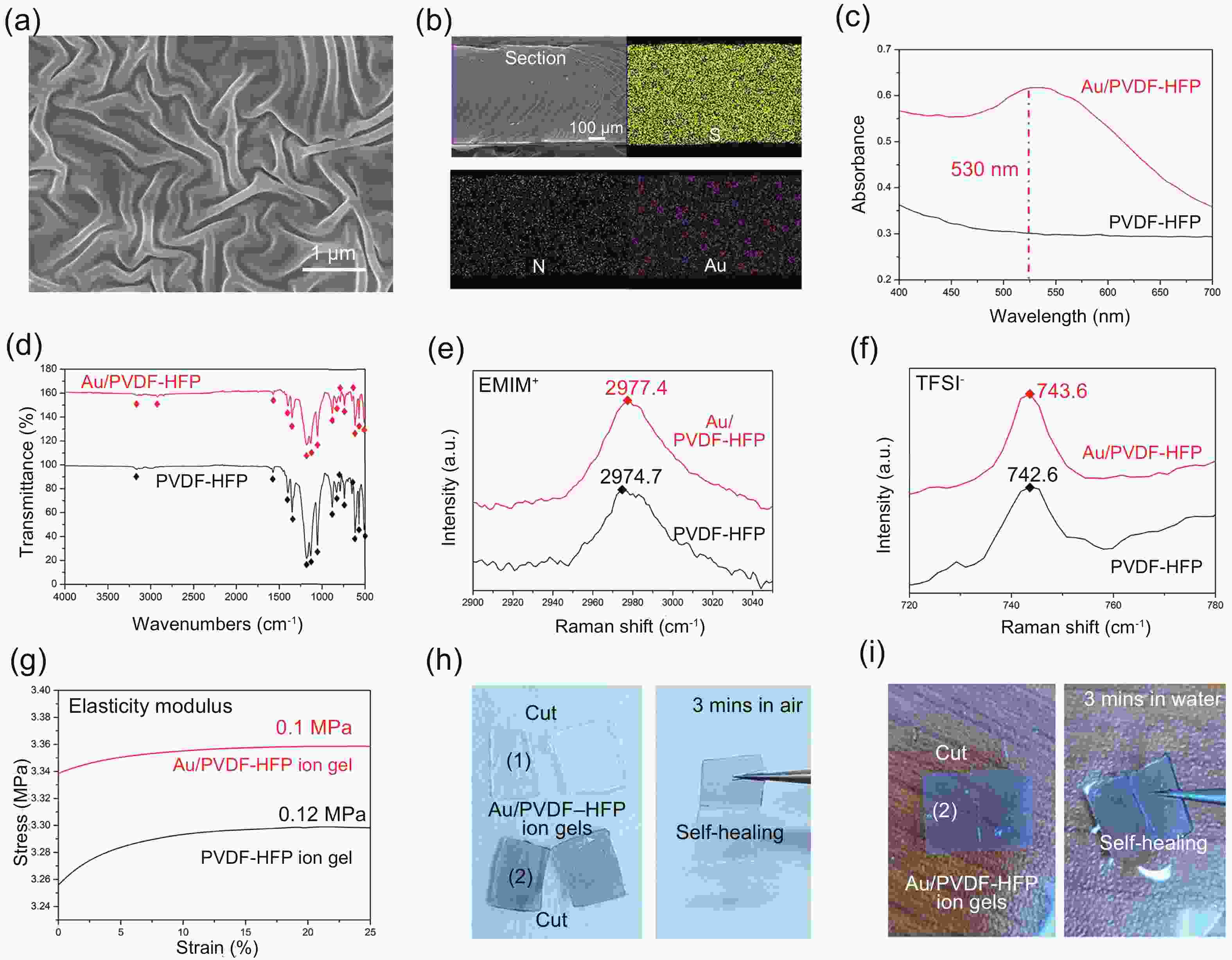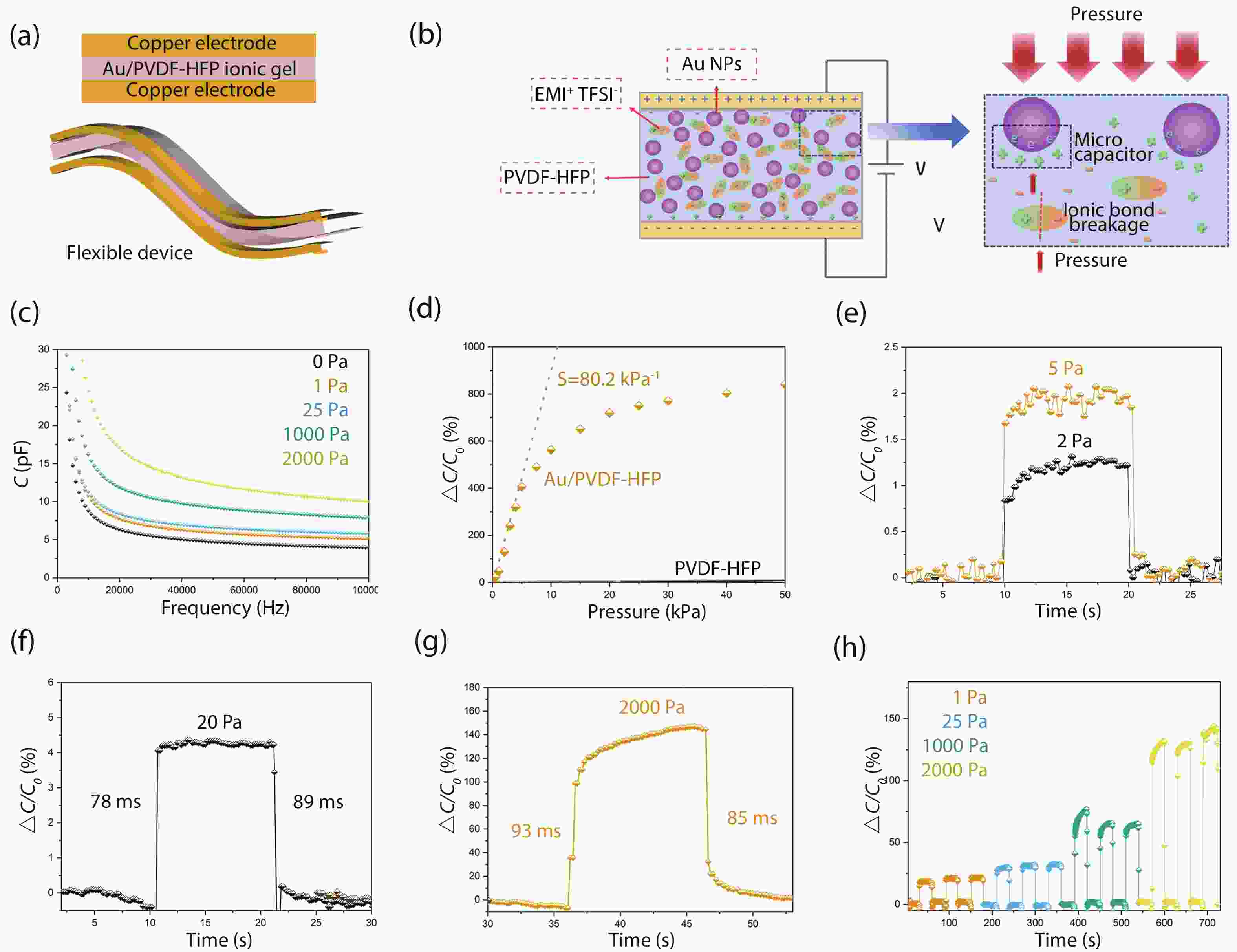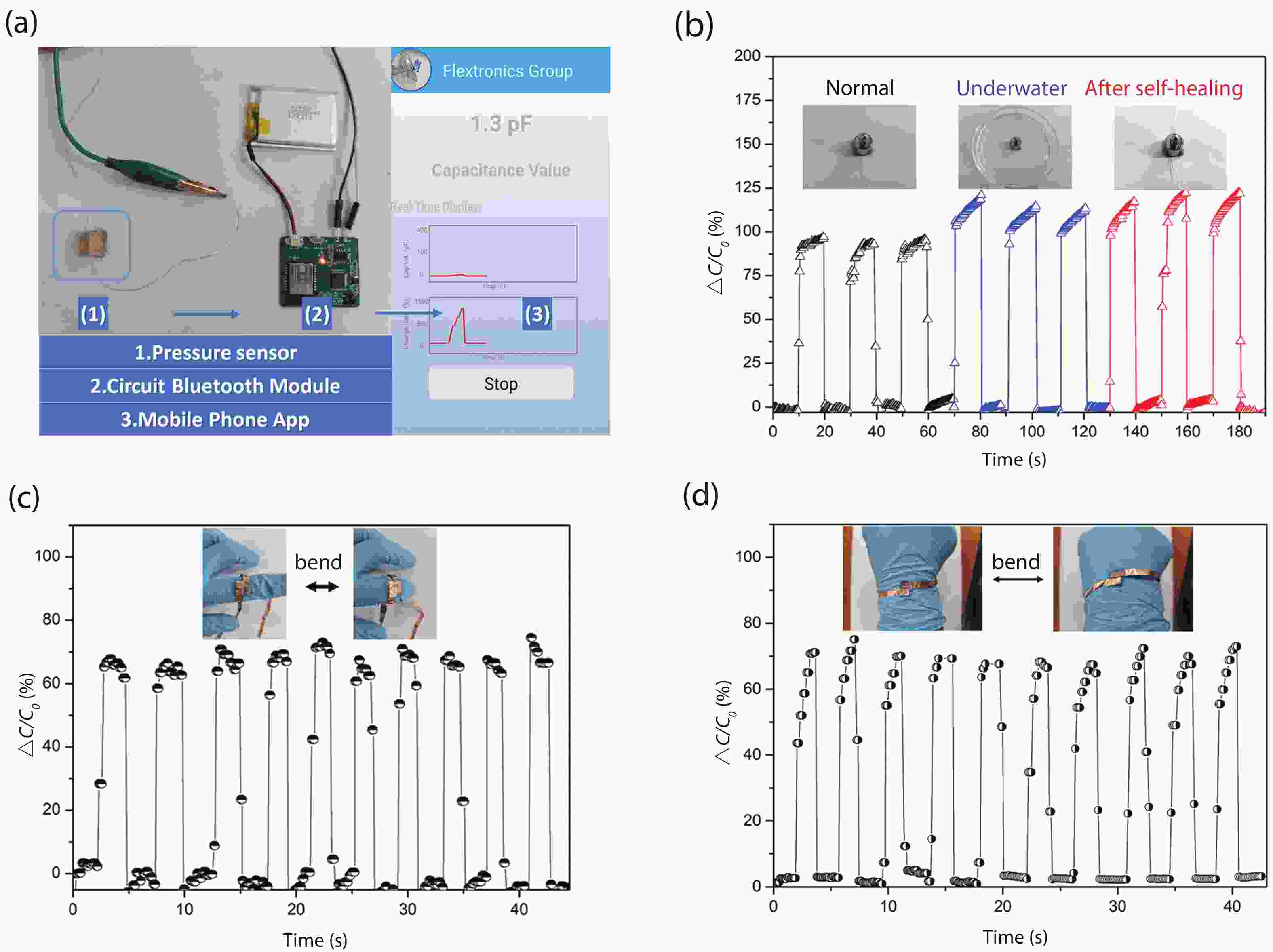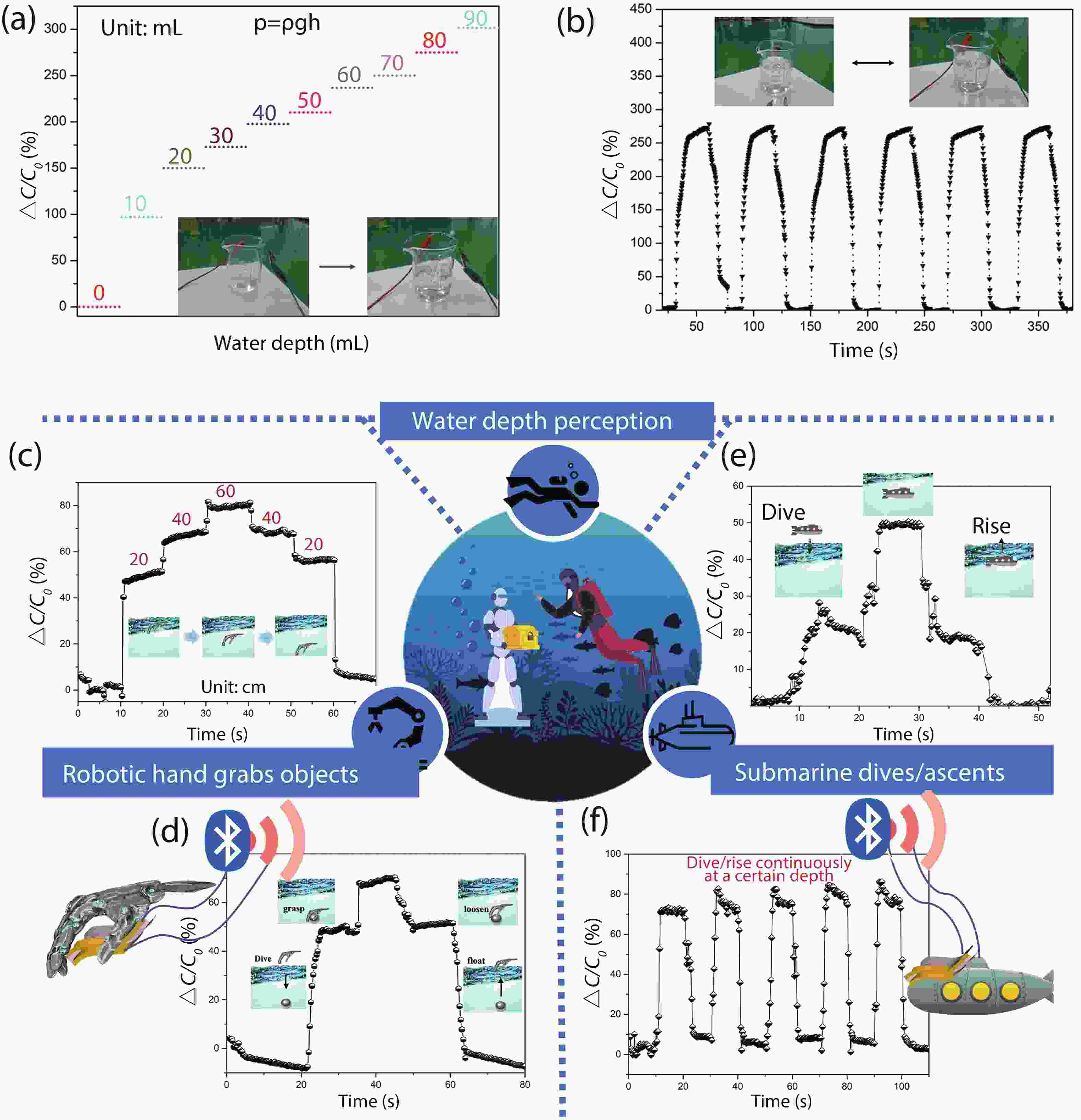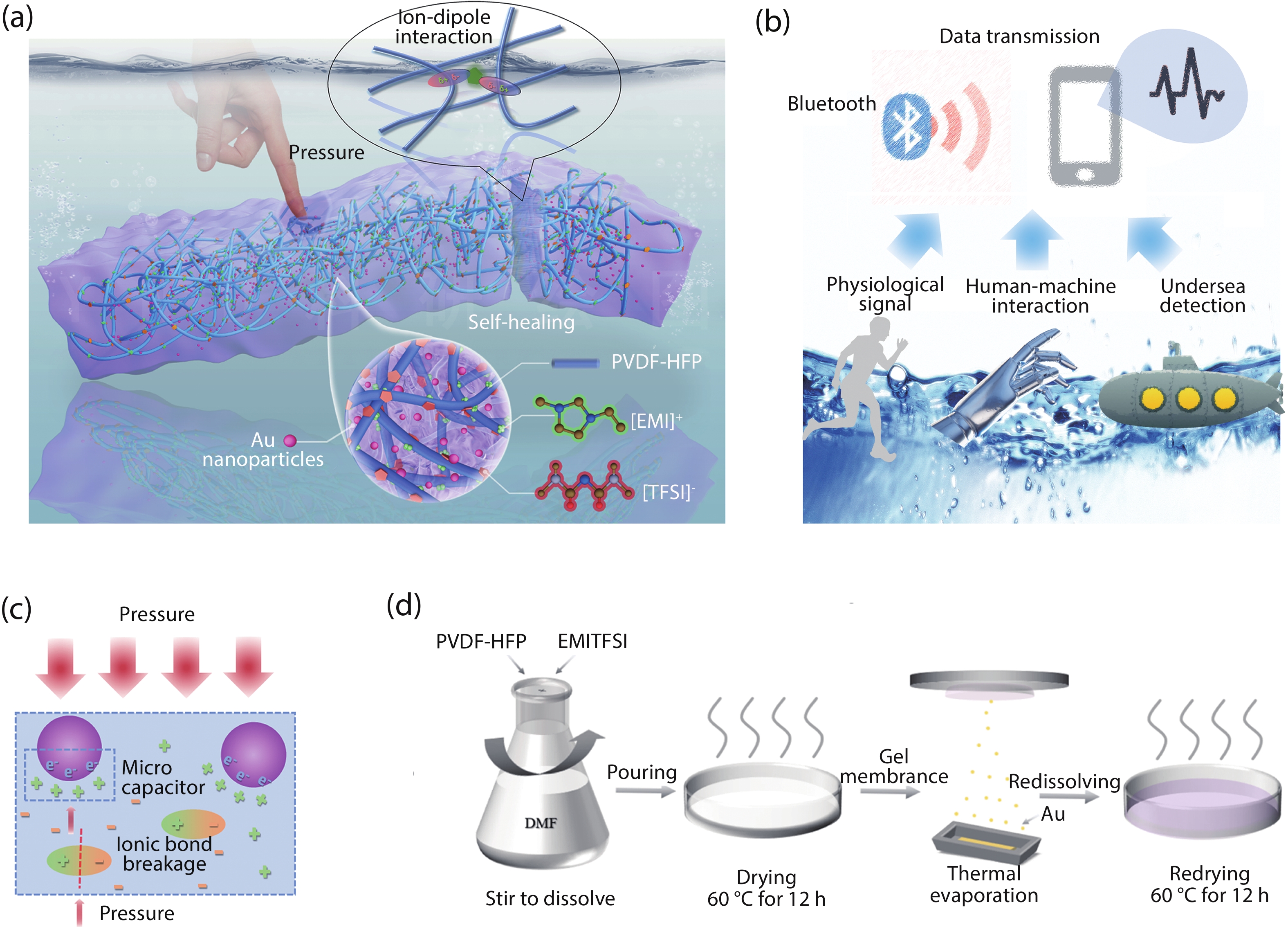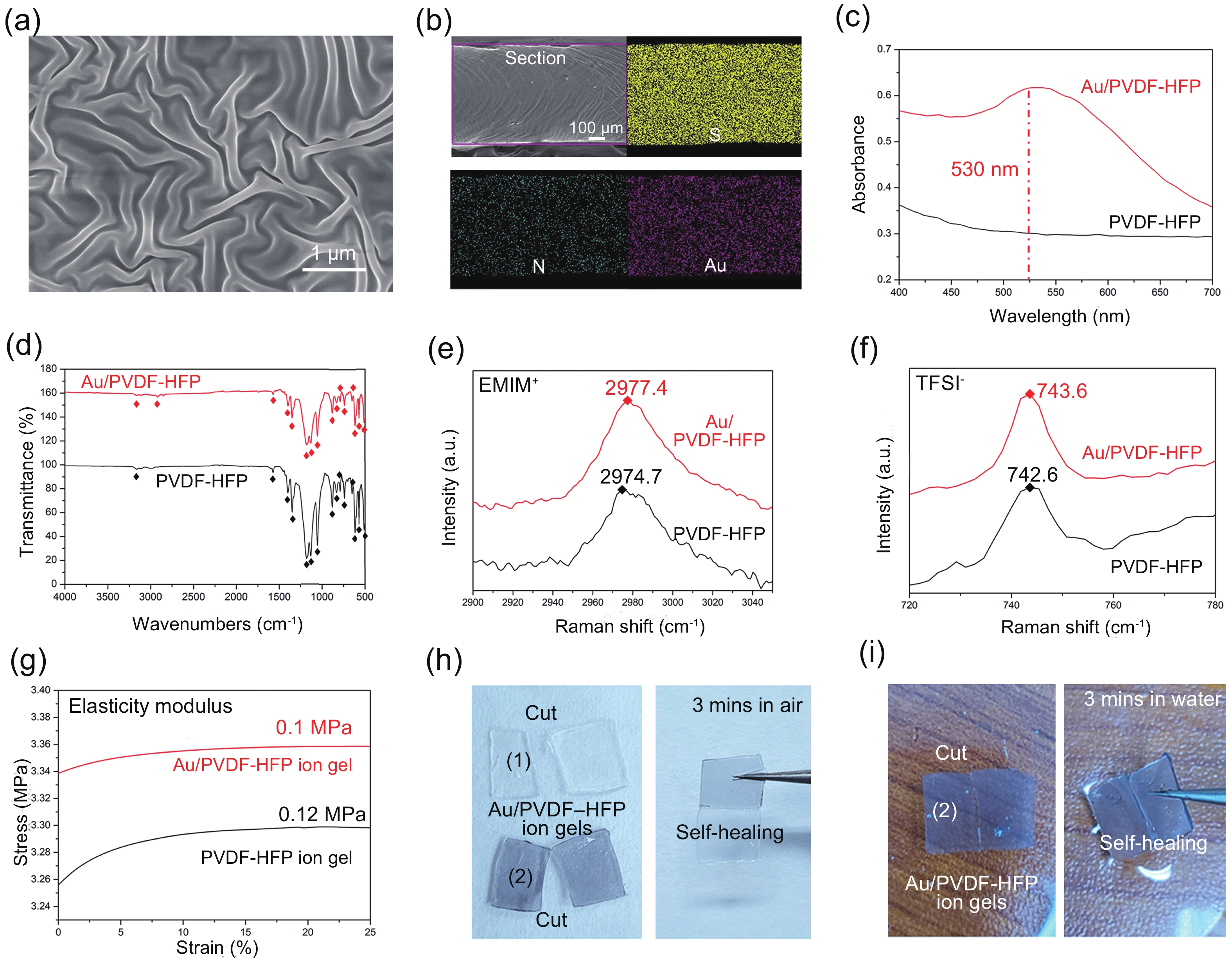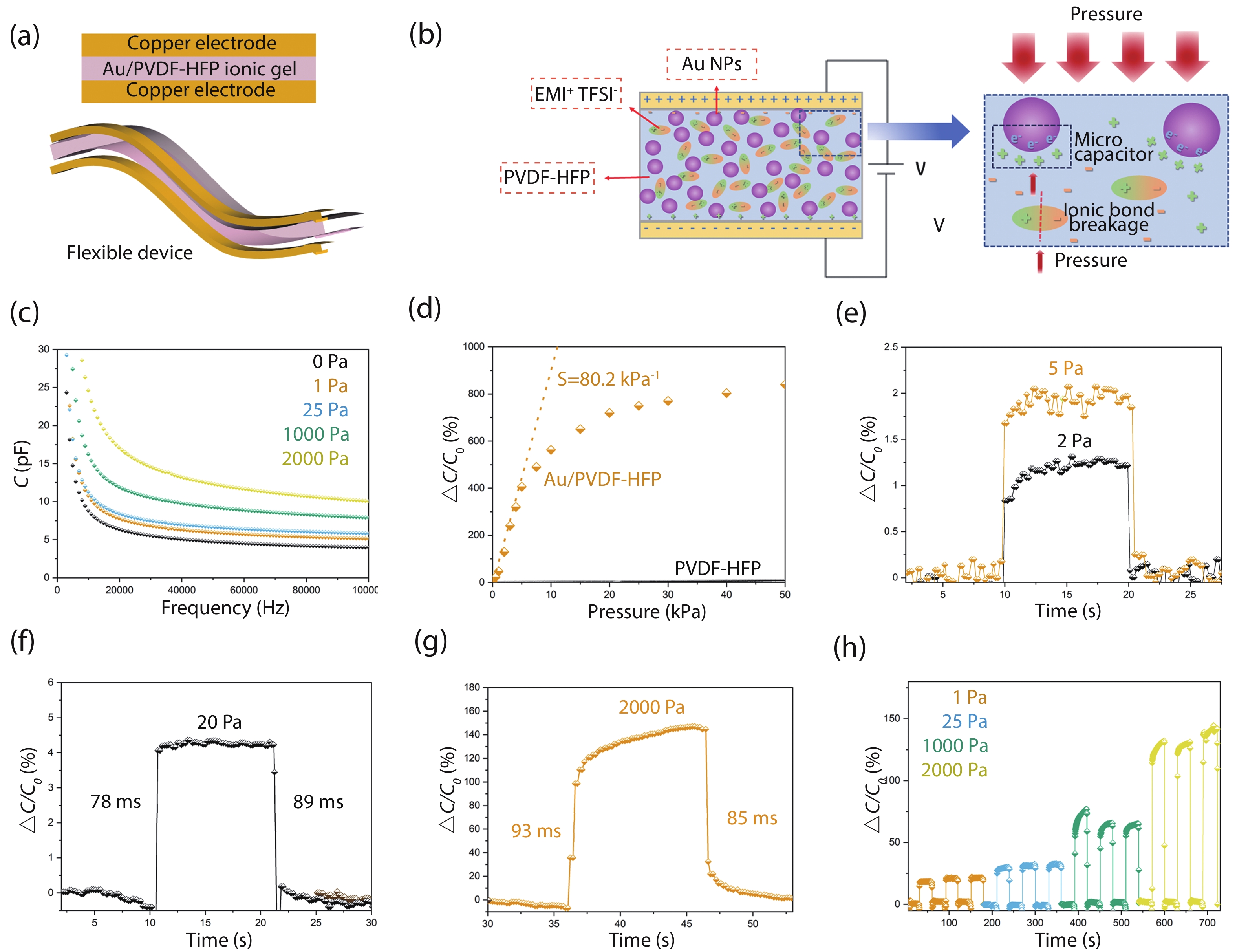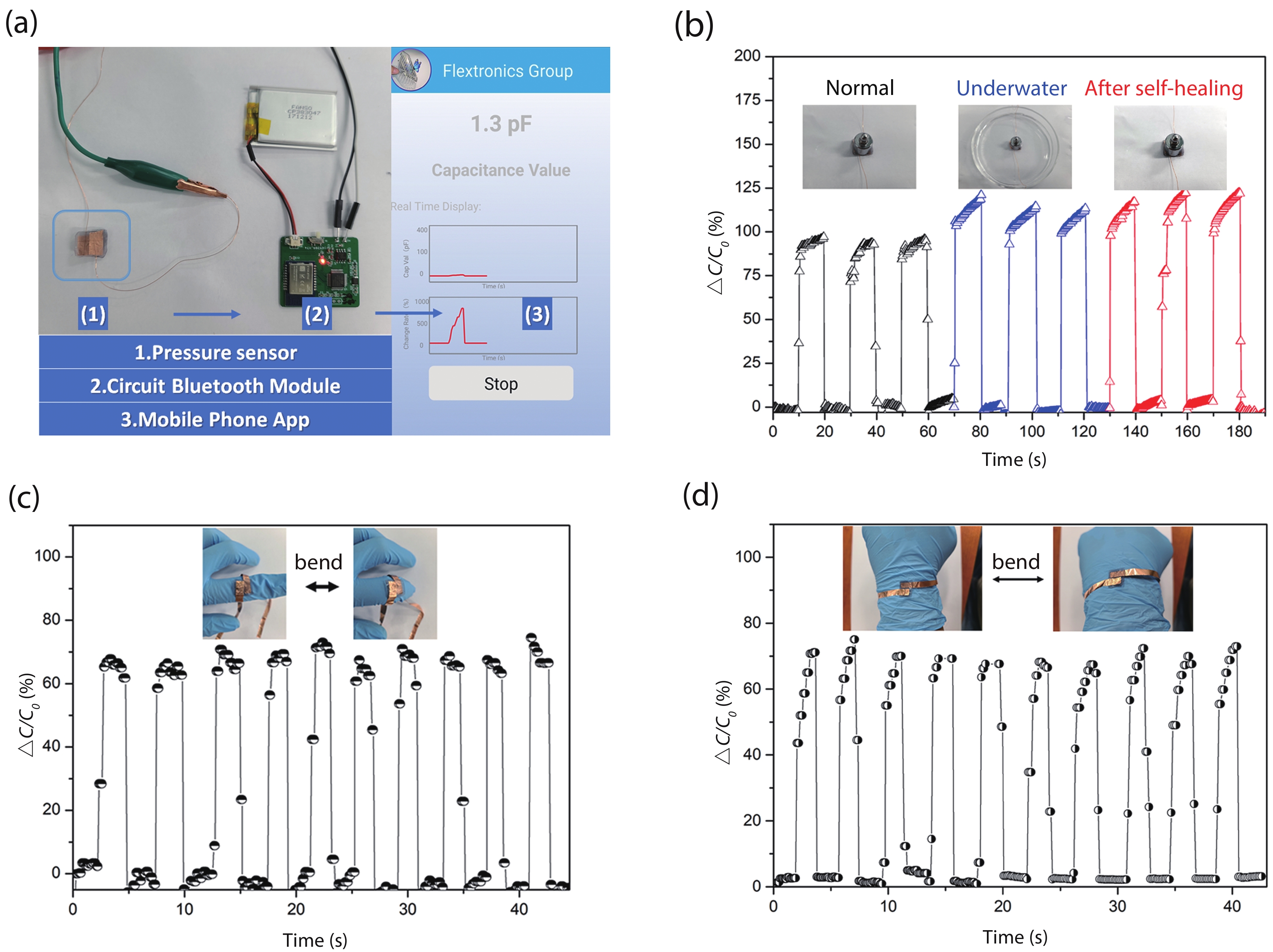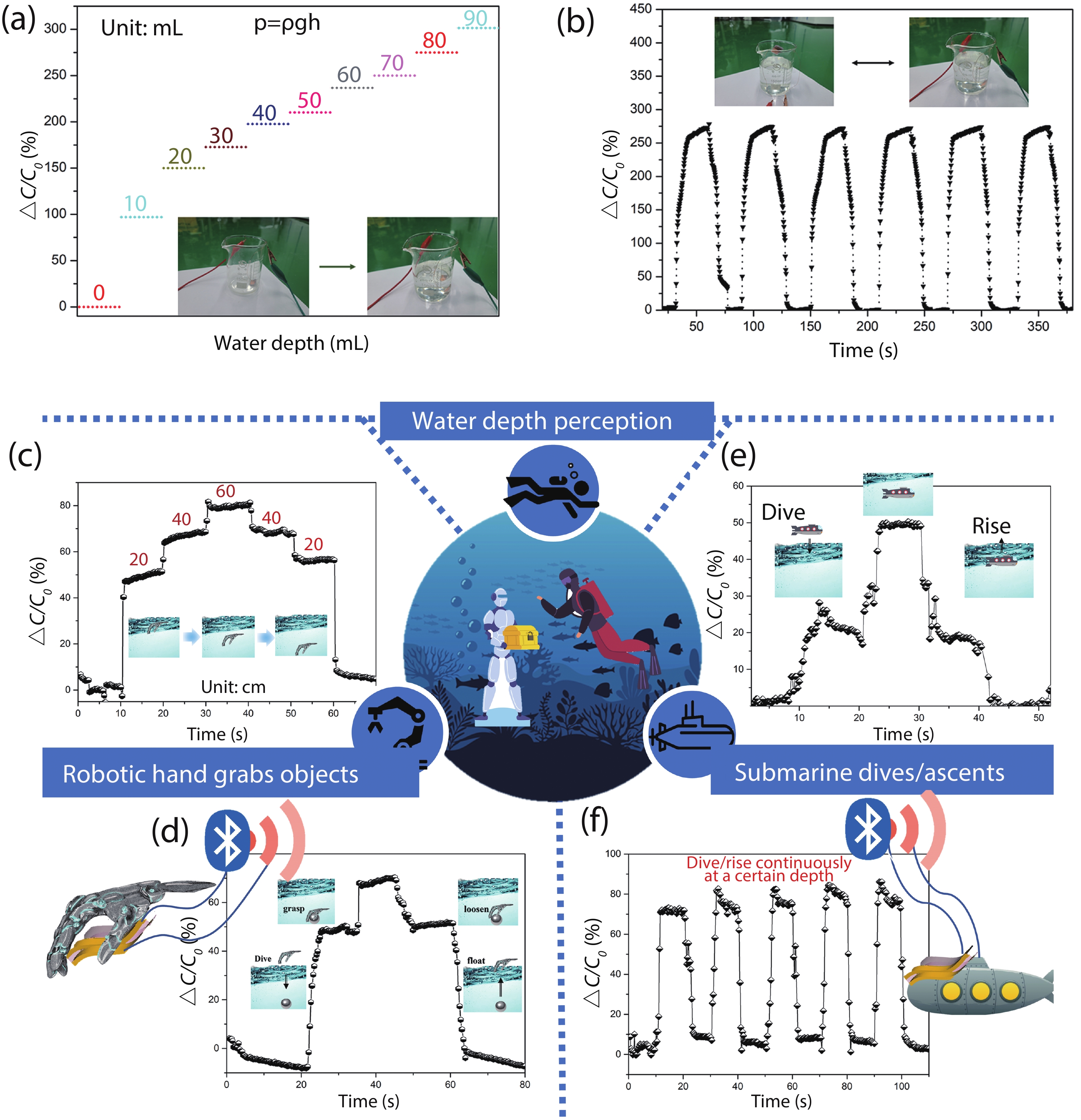| Citation: |
Ruiyang Yin, Linlin Li, Lili Wang, Zheng Lou. Self-healing Au/PVDF-HFP composite ionic gel for flexible underwater pressure sensor[J]. Journal of Semiconductors, 2023, 44(3): 032602. doi: 10.1088/1674-4926/44/3/032602
R Y Yin, L L Li, L L Wang, Z Lou. Self-healing Au/PVDF-HFP composite ionic gel for flexible underwater pressure sensor[J]. J. Semicond, 2023, 44(3): 032602. doi: 10.1088/1674-4926/44/3/032602
Export: BibTex EndNote
|
Self-healing Au/PVDF-HFP composite ionic gel for flexible underwater pressure sensor
doi: 10.1088/1674-4926/44/3/032602
More Information-
Abstract
Ionic gels can be potentially used in wearable devices owing to their high humidity resistance and non-volatility. However, the applicability of existing ionic gel pressure sensors is limited by their low sensitivity. Therefore, it is very important to develop an ionic gel pressure sensor with high sensitivity and a wide pressure detection range without sacrificing mechanical stretchability and self-healing ability. Herein, we report an effective strategy for developing pressure sensors based on ionic gel composites consisting of high-molecular-weight polymers, ionic liquids, and Au nanoparticles. The resulting capacitive pressure sensors exhibit high pressure sensitivity, fast response, and excellent self-healing properties. The sensors composed of highly hydrophobic polymers and ionic liquids can be used to track underwater movements, demonstrating broad application prospects in human motion state monitoring and underwater mechanical operations.-
Keywords:
- ionic gel,
- pressure sensor,
- high performance,
- underwater operation,
- self-healing
-
References
[1] Rogers J A, Someya T, Huang Y G. Materials and mechanics for stretchable electronics. Science, 2010, 327, 1603 doi: 10.1126/science.1182383[2] Wang D Y, Wang L L, Shen G Z. Nanofiber/nanowires-based flexible and stretchable sensors. J Semicond, 2020, 41, 041605 doi: 10.1088/1674-4926/41/4/041605[3] Darabi M A, Khosrozadeh A, Mbeleck R, et al. Skin-inspired multifunctional autonomic-intrinsic conductive self-healing hydrogels with pressure sensitivity, stretchability, and 3D printability. Adv Mater, 2017, 29, 1700533 doi: 10.1002/adma.201700533[4] Li L L, Zhao S F, Ran W H, et al. Dual sensing signal decoupling based on tellurium anisotropy for vr interaction and neuro-reflex system application. Nat Commun, 2022, 13, 5975 doi: 10.1038/s41467-022-33716-9[5] Zhao S F, Ran W H, Lou Z, et al. Neuromorphic-computing-based adaptive learning using ion dynamics in flexible energy storage devices. Natl Sci Rev, 2022, 9, nwac158 doi: 10.1093/nsr/nwac158[6] Mak P I. Lab-on-COS-an in-vitro diagnostic (IVD) tool for a healthier society. J Semicond, 2020, 41, 110301 doi: 10.1088/1674-4926/41/11/110301[7] Das C M, Kang L, Ouyang Q Y, et al. Advanced low-dimensional carbon materials for flexible devices. InfoMat, 2020, 2, 698 doi: 10.1002/inf2.12073[8] Park J, Hwang J C, Kim G G, et al. Flexible electronics based on one-dimensional and two-dimensional hybrid nanomaterials. InfoMat, 2020, 2, 33 doi: 10.1002/inf2.12047[9] Jiang H, Zheng L, Liu Z, et al. Two-dimensional materials: From mechanical properties to flexible mechanical sensors. InfoMat, 2020, 2, 1077 doi: 10.1002/inf2.12072[10] Hou Y X, Wang L, Sun R, et al. Crack-across-pore enabled high-performance flexible pressure sensors for deep neural network enhanced sensing and human action recognition. ACS Nano, 2022, 16, 8358 doi: 10.1021/acsnano.2c02609[11] Jia M, Yi C, Han Y, et al. Hierarchical network enabled flexible textile pressure sensor with ultrabroad response range and high-temperature resistance. Adv Sci, 2022, 9, 2105738 doi: 10.1002/advs.202105738[12] Chen M, Wang Z X, Ge X, et al. Controlled fragmentation of single-atom-thick polycrystalline graphene. Matter, 2020, 2, 666 doi: 10.1016/j.matt.2019.11.004[13] Yuk H, Lu B, Zhao X, et al. Hydrogel bioelectronics. Chem Soc Rev, 2019, 48, 1642 doi: 10.1039/C8CS00595H[14] Lei Z Y, Wang Q K, Sun S, et al. A bioinspired mineral hydrogel as a self-healable, mechanically adaptable ionic skin for highly sensitive pressure sensing. Adv Mater, 2017, 29, 1700321 doi: 10.1002/adma.201700321[15] Zhang H, Han W, Xu K, et al. Metallic sandwiched-aerogel hybrids enabling flexible and stretchable intelligent sensor. Nano Lett, 2020, 20, 3449 doi: 10.1021/acs.nanolett.0c00372[16] Ma Z, Kong D S, Pan L J, et al. Skin-inspired electronics: emerging semiconductor devices and systems. J Semicond, 2020, 41, 041601 doi: 10.1088/1674-4926/41/4/041601[17] Kim Y, Liu M J, Ishida Y, et al. Thermoresponsive actuation enabled by permittivity switching in an electrostatically anisotropic hydrogel. Nat Mater, 2015, 14, 1002 doi: 10.1038/nmat4363[18] Fukushima T, Asaka K, Kosaka A, et al. Fully plastic actuator through layer-by-layer casting with ionic-liquid-based bucky gel. Angew Chem Int Ed, 2005, 44, 2410 doi: 10.1002/anie.200462318[19] He Y, Sun J, Qian C, et al. Solution-processed natural gelatin was used as a gate dielectric for the fabrication of oxide field-effect transistors. Org Electron, 2016, 38, 357 doi: 10.1016/j.orgel.2016.09.017[20] Lu Y, Qu X, Zhao W, et al. Highly stretchable, elastic, and sensitive mxene-based hydrogel for flexible strain and pressure sensors. Research, 2020, 2020, 2038560 doi: 10.34133/2020/203856[21] Yang J, Yu X, Sun X, et al. Polyaniline-decorated supramolecular hydrogel with tough, fatigue-resistant, and self-healable performances for all-in-one flexible supercapacitors. ACS Appl Mater Interfaces, 2020, 12, 9736 doi: 10.1021/acsami.9b20573[22] Cheng H, He X, Fan Z, et al. Flexible quasi-solid state ionogels with remarkable seebeck coefficient and high thermoelectric properties. Adv Energy Mater, 2019, 9, 1901085 doi: 10.1002/aenm.201901085[23] Shen Z, Zhu X, Majidi C, et al. Cutaneous ionogel mechanoreceptors for soft machines, physiological sensing, and amputee prostheses. Adv Mater, 2021, 33, 2102069 doi: 10.1002/adma.202102069[24] Kwon J, Kim Y, Moon H, et al. Porous ion gel: A versatile ionotronic sensory platform for high-performance, wearable ionoskins with electrical and optical dual output. ACS Nano, 2021, 15, 15132 doi: 10.1021/acsnano.1c05570[25] Wang Y, Huang J. Recent advancements in flexible humidity sensors. J Semicond, 2020, 41, 040401 doi: 10.1088/1674-4926/41/4/040401[26] Ma Y, Zhang Y, Cai S, et al. Flexible hybrid electronics for digital healthcare. Adv Mater, 2020, 32, 1902062 doi: 10.1002/adma.201902062[27] Ma X H, Jiang Z F, Lin Y J. Flexible energy storage devices for wearable bioelectronics. J Semicond, 2021, 42, 101602 doi: 10.1088/1674-4926/42/10/101602[28] Li C, Li P, Yang S, et al. Recently advances in flexible zinc ion batteries. J Semicond, 2021, 42, 101603 doi: 10.1088/1674-4926/42/10/101603[29] Zhang Z, Chen C, Fei T, et al. Wireless communication and wireless power transfer system for implantable medical device. J Semicond, 2020, 41, 102403 doi: 10.1088/1674-4926/41/10/102403[30] Zhao S F, Ran W H, Wang L L, et al. Interlocked MXene/rGO aerogel with excellent mechanical stability for a health-monitoring device. J Semicond, 2022, 43, 082601 doi: 10.1088/1674-4926/43/8/082601[31] Fang Y, Cheng H, He H, et al. Stretchable and transparent ionogels with high thermoelectric properties. Adv Funct Mater, 2020, 30, 2004699 doi: 10.1002/adfm.202004699[32] Xu L, Huang Z, Deng Z, et al. A transparent, highly stretchable, solvent-resistant, recyclable multifunctional ionogel with underwater self-healing and adhesion for reliable strain sensors. Adv Mater, 2021, 33, 2105306 doi: 10.1002/adma.202105306[33] Cao Y, Tan Y, Li S, et al. Self-healing electronic skins for aquatic environments. Nat Electron, 2019, 2, 75 doi: 10.1038/s41928-019-0206-5[34] Ren Y, Guo J, Liu Z, et al. Ionic liquid-based click-Ionogels. Sci Adv, 2019, 5, eaax0648 doi: 10.1126/sciadv.aax0648[35] Cao Y, Morrissey T, Acome E, et al. A transparent, self-healing, highly stretchable ionic conductor. Adv Mater, 2017, 29, 1605099 doi: 10.1002/adma.201605099[36] Li T, Wang Y, Li S, et al. Mechanically robust, elastic, and healable ionogels for highly sensitive ultra-durable ionic skins. Adv Mater, 2020, 32, 2002706 doi: 10.1002/adma.202002706[37] Keum K, Eom J, Lee J, et al. Fully-integrated wearable pressure sensor array enabled by highly sensitive textile-based capacitive ionotronic devices. Nano Energy, 2021, 79, 105479 doi: 10.1016/j.nanoen.2020.105479[38] Chen M, Luo W, Xu Z, et al. An ultrahigh resolution pressure sensor based on percolative metal nanoparticle arrays. Nat Commun, 2019, 10, 4024 doi: 10.1038/s41467-019-12030-x[39] Shi L, Li Z, Chen M, et al. Quantum effect-based flexible and transparent pressure sensors with ultrahigh sensitivity and sensing density. Nat Commun, 2020, 11, 3529 doi: 10.1038/s41467-020-17298-y[40] Gong S. Schwalb W, Wang Y, et al. A wearable and highly sensitive pressure sensor with ultrathin gold nanowires. Nat Commun, 2014, 5, 3132 doi: 10.1038/ncomms4132[41] Mannsfeld S, Tee B C K, Stoltenberg R M, et al. Highly sensitive flexible pressure sensors with microstructured rubber dielectric layers. Nat Mater, 2010, 9, 859 doi: 10.1038/nmat2834[42] Burnworth M, Tang L, Kumpfer J, et al. Optically healable supramolecular polymers. Nature, 2011, 472, 334 doi: 10.1038/nature09963[43] Meis CM, Grosskopf AK, Correa S, et al. Injectable supramolecular polymer-nanoparticle hydrogels for cell and drug delivery applications. J Vis Exp, 2021, 168, e62234 doi: 10.3791/62234[44] Appel E, Tibbitt M, Webber M, et al. Self-assembled hydrogels utilizing polymer-nanoparticle interactions. Nat Commun, 2015, 6, 6295 doi: 10.1038/ncomms7295 -
Proportional views





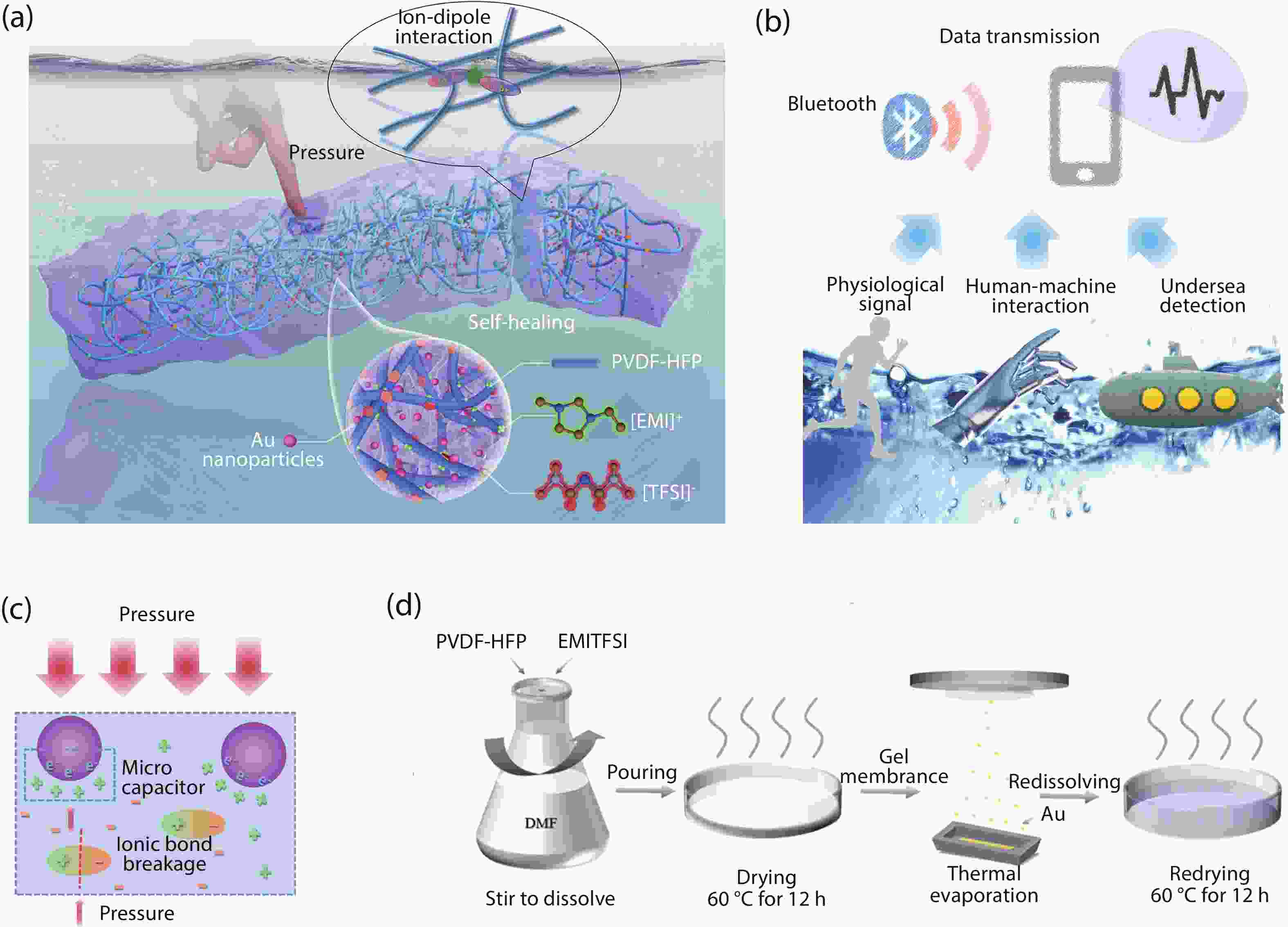
 DownLoad:
DownLoad:
